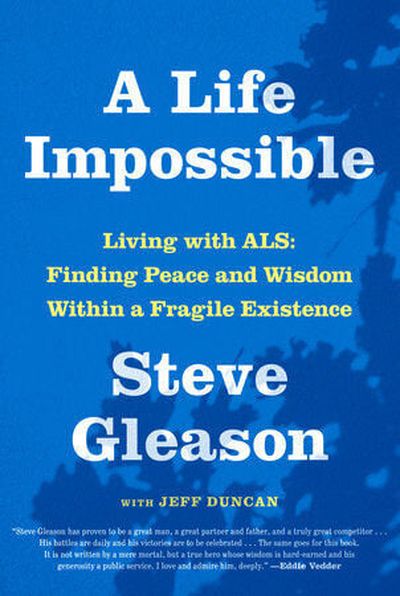Book review: Steve Gleason’s ‘A Life Impossible’ shows a life possible with ALS

“Ten years past my expiration date,” is how 47-year-old Steve Gleason describes his life after his diagnosis of amyotrophic lateral sclerosis, or Lou Gehrig’s Disease, in 2011 and being told he only had a few years left to live.
In “A Life Impossible: Living With ALS: Finding Peace and Wisdom Within a Fragile Existence,” the book he wrote with the help of sports columnist Jeff Duncan, Gleason gives insight on his life prior to and after his diagnosis of the ALS, a disease that attacks the nervous system, leaving a person unable to move or breath on their own.
A Spokane native and Washington State University alum, Gleason was an athletic celebrity during his time at Gonzaga Prep and in Pullman. He eventually went on to play on special teams for the New Orleans Saints, where he met his wife, Michel, in the unfamiliar city and made a game-changing block within minutes of the first game at the Saints’ stadium after Hurricane Katrina.
Shortly after his retirement from the NFL in 2008, he began to experience twitches in his upper arms and shoulder but did not think anything of it because he assumed it was a result of playing football for so long.
It wasn’t until he lost in a pull-up competition with a friend in 2010 that he realized something was seriously wrong and spoke with a doctor, who brought up the seemingly small possibility of ALS. Because the disease was such a minuscule idea at the time, Gleason started off by testing for molecular and metabolic issues with no luck.
After months of trying to figure out what was wrong , Gleason received an official diagnosis for ALS, a disease that usually is diagnosed between ages 40 and 70.
His symptoms continued to get worse and more noticeable, and he eventually needed a walker and then a wheelchair, but he continued to make the most of his life and traveled with his wife and his son, Rivers, after he was born.
Despite his hope to keep his voice, Gleason began to record video messages to Rivers to look back on later in life when he couldn’t talk anymore.
Eventually, it became so difficult to speak to other people that Gleason got a computer to help him vocalize his thoughts. When he couldn’t move his fingers enough to type, he was able to use eye movements to type instead.
“A Life Impossible” follows Gleason’s struggles to navigate life after losing the ability to communicate with the people he loves.
He was on a ventilator that would beep if it became disconnected, so anyone around would be able to hear he needed help. But one day, the caregiver, Mike, was not near Gleason when it disconnected, and he had to rush to send a message to Mike before he lost too much air.
Gleason had gone an entire minute without breathing, and when he realized he was not going to die, “… there was an astounding, magical sense of ineffable joy that I was still around to love this miraculous and wonderful life,” he wrote in the book.
His life post-diagnosis was not only difficult for him, but for his family as well, and Gleason said his wife was almost like a single parent and his caretaker at the same time. The book details how she ended up living in a different apartment for a short period of time while filming the documentary “Gleason,” because her life at home had become so overwhelming.
But Gleason and his family were able to overcome his losses in multiple body functions and still make the most of what he could, beginning the Team Gleason Foundation to help support other people navigating an ALS diagnosis.
He was able to have a second child, his daughter Gray, and took his two children along when he received the Congressional Gold Medal four years ago. His son even had the opportunity to throw the first pitch at a Chicago Cubs game in 2022 to celebrate Lou Gehrig Day. Gleason just weeks ago was given the Courage Award at the 2024 ESPY Awards.
And, despite being told he would not make it past 2014, Gleason proves himself in “A Life Impossible” and shows a life living with ALS and how he overcame it.